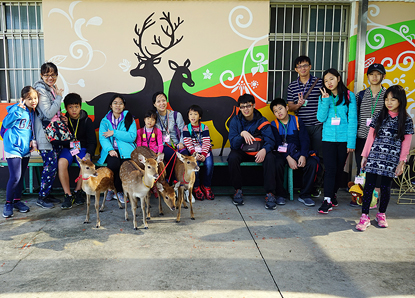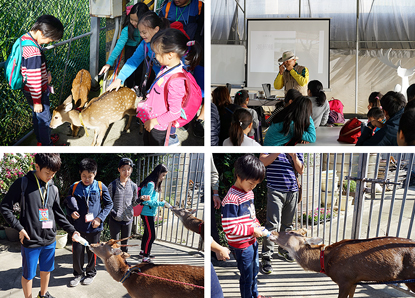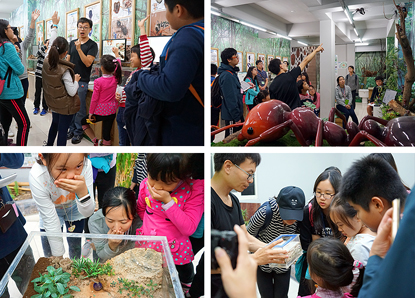Sketch of Archilife Study Tour, December 2018Date: 2019-01-15
Section: Activity |  12月份見識之旅活動,於2018年12月15日由呂明澐小姐帶領11位祐生見習生及家長們,進行桃園水鹿生態暨螞蟻地下王國解密之旅。活動開始之初,領隊呂明澐小姐提醒本次活動注意事項及觀察重點,先行建立見習生的背景知識。 12月份見識之旅活動,於2018年12月15日由呂明澐小姐帶領11位祐生見習生及家長們,進行桃園水鹿生態暨螞蟻地下王國解密之旅。活動開始之初,領隊呂明澐小姐提醒本次活動注意事項及觀察重點,先行建立見習生的背景知識。
For the study tour of December 15, 2018, Ms. Lu Ming-yun led 11 ARF interns and their parents on a tour to discover the secrets of the Formosan Sambar Deer and the underground empire of the ants in Taoyuan. At the start of the day's activities, team leader Ms. Lu Ming-yun reminded everyone about things to note and what to observe, and gave the interns some background knowledge.
 本次上午參訪山腳鹿場,行程一開始,導覽老師播放動畫短片,說明鹿角每年會脫落一次,自二歲時起開始分枝,最後形成三尖二叉的角,鹿茸則為公鹿茸角骨化變硬成鹿角前摘下的產物,多採自水鹿、梅花鹿與紅鹿,水鹿等到約二歲時即可頭剪,須經專業人士才得採摘。隨即解說水鹿生態,指出其眼下具有明顯的眼下腺,在生氣或興奮時會張開噴氣,又稱四目鹿,主要用以留下氣味來示威及吸引異性。隨後進行與小鹿賽跑活動,感受小鹿奔跑的速度與人之間的差距,並藉由小鹿餵奶體驗,培養見習生對動物友善愛護之心。 本次上午參訪山腳鹿場,行程一開始,導覽老師播放動畫短片,說明鹿角每年會脫落一次,自二歲時起開始分枝,最後形成三尖二叉的角,鹿茸則為公鹿茸角骨化變硬成鹿角前摘下的產物,多採自水鹿、梅花鹿與紅鹿,水鹿等到約二歲時即可頭剪,須經專業人士才得採摘。隨即解說水鹿生態,指出其眼下具有明顯的眼下腺,在生氣或興奮時會張開噴氣,又稱四目鹿,主要用以留下氣味來示威及吸引異性。隨後進行與小鹿賽跑活動,感受小鹿奔跑的速度與人之間的差距,並藉由小鹿餵奶體驗,培養見習生對動物友善愛護之心。
The tour began with a visit to Sanjiao Deer Farm in the morning. The tour guide started off with a short animation film. It explained that deer shed their antlers every year, and each antler begins to divide into branches when the deer are two years old, finally forming three points and two branches. Deer antler velvet is the precalcified antler of the buck, and is mostly harvested from the sambar deer, sika deer and red deer by professionals when they are approximately two years old. The Formosan sambar deer has conspicuous preorbital glands (located under the eyes) which dilate when they are angry or excited, giving them the name of "four-eyed deer", and they are mainly used to secrete scent to establish their dominance or attract the opposite sex. The tour also included a race event, allowing interns to experience the difference in speed between a deer and human, and a milk feeding session which encouraged the interns to love and care for animals.
 中午飯後,前往「螞蟻的家」生態館,該館以螞蟻生態為主題,旨在推動環保綠化之概念,改善居家生活環境。進入館內,由館主侯修煒先生進行導覽,首先帶出螞蟻是少數的社會性昆蟲,各司其職,同一蟻窩中有蟻后、工蟻、兵蟻及雄蟻四種職稱,詳細講述如何依身體特徵辨認,以及各自肩負的任務。接著教導眾人於戶外分辨蟻窩與虎頭蜂窩的方法,前者通常為包住樹枝的串丸子狀,有多個開口,後者係吊掛在樹枝上,僅一個開口;然館主警告極可能因光線問題造成誤判,故於戶外活動時若發現類似窩狀巢穴,應盡速離開,切勿驚擾,亦說明如不幸遇到虎頭蜂追趕應往順風處逃跑,或抓兩把鬆散泥沙朝其丟去,以阻絕氣味,並即刻遠離該處。緊接著,館主闡述入侵紅火蟻對台灣土地的危害與政府防治案例,解釋如何以天然無毒的方式根除。最後,館主透過養殖巢,讓眾人近距離觀察不同種類螞蟻的特徵與氣味,並實際將小蟲丟到蟻巢附近,展示螞蟻如何分工掠食與搬運。至此,本日活動已近尾聲,大家一起合照留念後搭車返程,並期待於下次見識之旅再相見。 中午飯後,前往「螞蟻的家」生態館,該館以螞蟻生態為主題,旨在推動環保綠化之概念,改善居家生活環境。進入館內,由館主侯修煒先生進行導覽,首先帶出螞蟻是少數的社會性昆蟲,各司其職,同一蟻窩中有蟻后、工蟻、兵蟻及雄蟻四種職稱,詳細講述如何依身體特徵辨認,以及各自肩負的任務。接著教導眾人於戶外分辨蟻窩與虎頭蜂窩的方法,前者通常為包住樹枝的串丸子狀,有多個開口,後者係吊掛在樹枝上,僅一個開口;然館主警告極可能因光線問題造成誤判,故於戶外活動時若發現類似窩狀巢穴,應盡速離開,切勿驚擾,亦說明如不幸遇到虎頭蜂追趕應往順風處逃跑,或抓兩把鬆散泥沙朝其丟去,以阻絕氣味,並即刻遠離該處。緊接著,館主闡述入侵紅火蟻對台灣土地的危害與政府防治案例,解釋如何以天然無毒的方式根除。最後,館主透過養殖巢,讓眾人近距離觀察不同種類螞蟻的特徵與氣味,並實際將小蟲丟到蟻巢附近,展示螞蟻如何分工掠食與搬運。至此,本日活動已近尾聲,大家一起合照留念後搭車返程,並期待於下次見識之旅再相見。
After lunch, everyone headed to Ant Home, an ecological museum which aims to promote the concept of environmental conservation and improving the home environment. The tour guide, Mr. Hou Xiu-wei, began by introducing ants as one of few species of social insects. Within each ant colony are four groups of ants, including the queens, workers, soldiers and male ants with identifiable characteristics and responsibilities. The tour guide taught everyone how to differentiate an ant nest and hornet nest; the former usually looks like a string of beads wrapped around a tree branch with many openings while the latter is hung on a tree branch with only one opening. The tour guide also warned of the risk of misjudging due to lighting. Thus, if one discovers such a nest during outdoor activities, one should leave it alone. When chased by hornets, it is prudent to run in the direction of the wind, or throw two handfuls of loose dirt toward them to block your scent and escape immediately. Next, the tour guide explained the hazards caused by red imported fire ants, and government regulations to prevent and solve the problem, and explained how to get rid of them by using natural, non-toxic method. In the final part of the tour, everyone was able to observe the characteristics and scent of different types of ants through the museum's artificial nests, and saw how the ants divide their labor capturing their prey and moving it when a worm was thrown near the nest. At this point, the day's itinerary came to an end. Everyone took a group photo before heading back and looked forward to the next study tour.
|
|